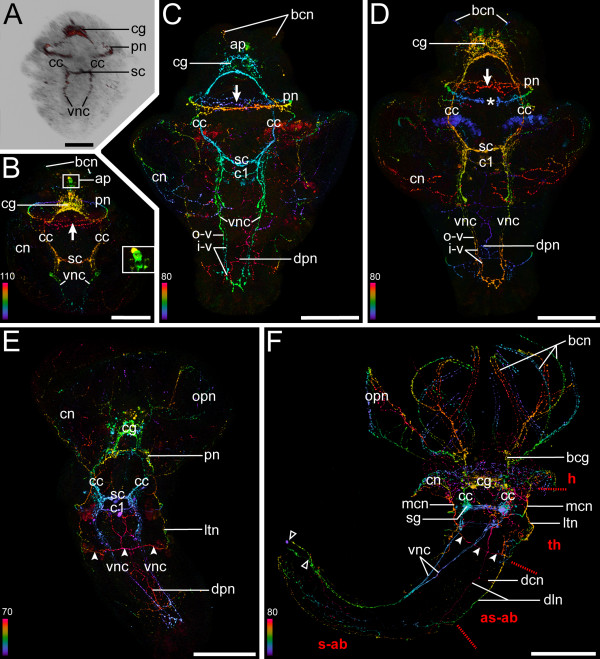Figure 3.
Serotonergic neurogenesis in Spirorbis cf. spirorbis. All confocal images are depth-coded except for (A) which is an overlay of a light and the respective confocal image. Anterior faces upwards, color bars indicate thickness of specimens in μm. Scale bars: 50 μm (A); 60 μm (B-D); 75 μm (E-F). Dorsal view in (A, C, E-F) and ventral view in (B and D). (A-B) Encapsulated larva. (A) The cerebral ganglion (cg), the circumesophageal connectives (cc), the ventral nerve cords (vnc), the prototroch nerve ring (pn), and the subesophageal commissure (sc) have started to form. (B) Note the neuronal network of the collar (cn), the cross-linked fibers of the prototroch nerve ring on the ventral side (arrow), the apical perikarya (ap) (magnified in inset), and the neurons of the branchial crown (bcn). (C-D) Free-swimming larva. (C) One additional commisure (c1) and dorsal peripheral neurons (dpn) are present. The ventral nerve cords consist of inner (i-v) and outer (o-v) neurites. (D) Note the dorsal gap in the prototroch nerve ring (asterisk). (E) Settled larva with neurons innervating the operculum (opn), lateral longitudinal nerves (ltn), and a transversal thorax nerve (arrowheads). (F) Settled juvenile with head (h), thorax (th), asetigerous-abdomen (as-ab), and setigerous-abdomen (s-ab). Subesophageal ganglia (sg) and branchial crown ganglia (bcg) develop, together with one main collar neuron (mcn) on either side. The ventral nerve cords (vnc) are not fused at the posterior-most end (open arrowheads). Paired dorsal longitudinal neurons (dln) with a commissural neuron (dcn) appear.

